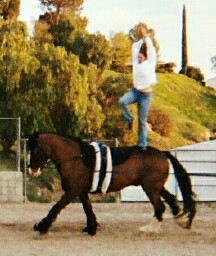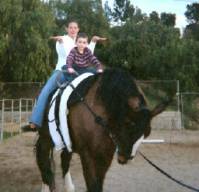Classical Equus Royal Vaulters
Frequently Asked
Questions
 What is Vaulting?
What is Vaulting?
Most
commonly defined Vaulting is the art and sport of gymnastics on the back of a
moving horse. Vaulting also has many elements similar to dance, ice skating ,
and other equestrian activities. The concept of vaulting is to mount a moving
horse, perform a delicate gymnastics routine, and then gracefully dismount.
Similar to ice skating or gymnastics, vaulting has both compulsory events and
freestyle routines called "Kürs" set to music. Vaulters can compete
in individual, pairs, and team events on the national and international level.
What
is all that “funny” equipment for?
All of
the equipment used in vaulting is specialized to offer the best possible, and
safest, situation for successful vaulting.
Typical Vaulting equipment includes a leather belt with two handles attached called
a surcingle. Between the horse and the surcingle is a pad to protect the horses
back. Between the bridle and surcingle is a pair of reins, these are called
side reins. Attached to the horse's bridle is a lounge line, usually 25 to 50
feet in length. At the end of the line is a person called a longeur. The Lounger stands in the center of the
circle guiding the horse though the lounge line and through a lounge whip. The
whip is longer than a normal lounge whip; about 25+ feet including lash. The
Vaulter also has special equipment. The vaulter usually wears tight fitting
spandex pants for practice with a suitable shirt. For competitions or other exhibitions
a full body spandex type suit is worn, this is called a unitard (a leotard with
legs). There is also a special type of footwear the a vaulter must have, these
are vaulting shoes. More Information on Vaulting
Equipment.
 Who can Vault?
Who can Vault?
Vaulting is an activity for everyone at any age. These teams are
geared for kids ages 8 to young adult. Some teams also welcome young children,
who have the ability to focus. Some teams even teach the mentally and
physically challenged.
How do I get started?
Find a team near you and give them a call! Most teams do not charge
for the first lesson so you can see if you like vaulting, or if you like the
team itself. Every Team is different. Some teams are geared more towards
competing, others are more laid back focusing on having fun and not perfection,
still others put more emphasis on the life lessons that vaulting teaches. Knowing
where you want to take your vaulting will help you choose a team that is right
for you. A list of teams is available at the American
Vaulting Association.
Is Vaulting safe?

Yes, Vaulting has an excellent safety record! All Vaulting teams
sponsored by the American Vaulting Association are required to
submit safety reports consisting of contact hours record and illness/injury
report. Each year the results are published in Vaulting World magazine.
Studies have shown Vaulting to be one of the safest of all the equestrian
disciplines. This is due to the nature of vaulting. The horse is controlled by
an experienced longeur and not by the vaulter. Vaulting is performed in a ring
with soft footing and free of any obstacles. Vaulting horses are required to be
of a gentle disposition, at least six years old and be a mare or gelding.
Vaulters are trained in the proper techniques to fall and roll from the horse.
Vaulters first learn vaulting exercises and movements on a stationary vaulting
barrel, then practice them on the horse at the walk, trot and canter. The risk
of serious injury while vaulting is minimal when compared to other every-day
childrens activities such as roller-bladeing or bike riding.
Why are helmets not worn when Vaulting?
Studies have shown that helmets are not necessary when Vaulting. In
fact, wearing helmets can actually increase the risk of injury to the vaulter
and horse. For more information read the
American Medical Equestrian Association article titled Vaulting Safety and the Use of
Protective Headgear.
How much does Vaulting cost?
Teams need to raise money in order to cover the year-round care and
support of the horses, equipment and facilities. Usually teams do this through
sponsorships and through charging for lessons. The lesson amount varies by team
but is in the range of $60 to $135 monthly per vaulter when averaged. Each team
has their own collection method which could be monthly, quarterly, etc.
Vaulters usually compete at local competitions and many go to
regional and national competitions. A local horse competition typically costs
$60 to $80. Competition vaulters will also incur costs for AVA registrations,
uniform, etc.
Home Current Classes Paperwork Demonstrations Our Horses Pictures F.A.Q. Contact Us
